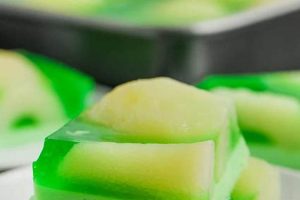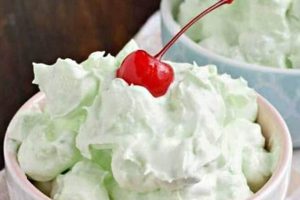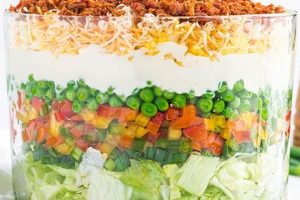Congealed salads featuring lime-flavored gelatin were a staple of mid-20th century American cuisine. These dishes often incorporated ingredients such as canned fruit, cottage cheese, whipped cream, or miniature marshmallows, suspended within the jiggly, green base. A classic example might involve a combination of lime gelatin, crushed pineapple, and cream cheese.
These desserts offered a visually appealing and refreshing treat, particularly suitable for warm weather gatherings. Their simple preparation and relatively inexpensive ingredients made them accessible to a broad range of households. Their popularity reflects a specific cultural moment and culinary aesthetic, offering a nostalgic glimpse into past foodways. The recipes continue to evoke a sense of retro charm and familial tradition for many.
Further exploration will delve into specific variations of these vintage recipes, examining ingredient choices, preparation techniques, and the sociocultural context surrounding their enduring appeal.
Tips for Creating Classic Lime Gelatin Salads
Achieving optimal texture and flavor in lime-flavored gelatin salads requires attention to several key details. The following tips offer guidance for successful preparation.
Tip 1: Gelatin Dissolution: Ensure complete dissolution of the gelatin powder in boiling water before adding cold liquids. Undissolved granules result in a grainy texture.
Tip 2: Mold Preparation: Lightly oiling the mold before adding the gelatin mixture ensures easy release once the salad is set.
Tip 3: Ingredient Incorporation: Allow the gelatin to partially set before adding fruits or other ingredients to prevent them from sinking or floating unevenly.
Tip 4: Layering for Visual Appeal: Creating layered salads with contrasting colors and textures enhances visual appeal. Allow each layer to set firmly before adding the next.
Tip 5: Balancing Sweetness and Tartness: Adjust the sweetness by adding a small amount of sugar or sweetener to the lime gelatin mixture, if desired. The tartness of the lime can be balanced with the addition of sweeter ingredients such as canned fruits.
Tip 6: Chilling Time: Sufficient chilling time is crucial for proper setting. Allow the salad to chill in the refrigerator for at least four hours, or preferably overnight, before serving.
Tip 7: Serving Suggestions: These salads can be served as a side dish or a light dessert. Garnish with whipped cream, fresh mint, or a sprinkle of toasted nuts for added elegance.
Adherence to these tips will result in visually appealing and flavorful gelatin salads, reminiscent of classic recipes.
By understanding these fundamental principles, one can appreciate the nuanced art of creating a perfect lime gelatin salad.
1. Lime
Lime flavor forms the cornerstone of these distinctive desserts, contributing the characteristic tartness that defines the overall sensory experience. Understanding lime’s role extends beyond mere flavoring; it influences texture, complements other ingredients, and contributes to the cultural and historical significance of these dishes.
- Flavor Profile
Lime’s tartness offers a refreshing counterpoint to the sweetness of other ingredients, creating a balanced flavor profile. This balance was particularly appealing in an era preceding readily available, intensely sweet artificial flavors. The natural acidity also contributes to the preservation of the other components.
- Cultural Context
The availability of lime-flavored products, particularly in the post-war era, coincides with the rise in popularity of these congealed salads. Lime’s association with tropical locales likely contributed to the perception of these dishes as exotic and festive.
- Interaction with Gelatin
Lime juice, with its acidic nature, interacts with the gelatin, influencing the setting process. Achieving the proper balance ensures optimal texture and structural integrity of the finished product. Recipes often specify bottled lime juice for consistency.
- Visual Appeal
The vibrant green hue imparted by lime flavoring contributes to the visual appeal of these salads, enhancing their attractiveness as a centerpiece or dessert offering. This bright color was often considered festive and celebratory.
The interplay of these factors solidifies lime’s crucial role, extending beyond a simple flavoring agent to a defining characteristic of these vintage recipes. The specific qualities of lime contribute significantly to the enduring appeal and nostalgic charm of these dishes. Its tartness, cultural associations, and chemical interaction with other components make it an indispensable element of the classic lime gelatin salad.
2. Gelatin
Gelatin plays a crucial role in defining the texture and structure of classic lime-flavored gelatin salads. Its unique properties allow for the creation of a jiggly, semi-solid form that suspends other ingredients, creating the distinctive presentation associated with these dishes. Examining the various facets of gelatin’s functionality reveals its importance in these retro recipes.
- Textural Properties
Gelatin’s ability to transform from a liquid to a semi-solid state is fundamental to the appeal of these salads. The resulting texture, often described as “jiggly” or “wobbly,” provides a unique sensory experience. This textural element contributes significantly to the nostalgic appeal of these dishes, evoking memories of specific time periods and culinary traditions.
- Structural Integrity
Gelatin acts as a binding agent, suspending fruits, vegetables, and other ingredients within its matrix. This structural integrity allows for the creation of visually appealing layered desserts, where different colors and textures are showcased. Maintaining this structure requires careful attention to temperature and ingredient ratios.
- Historical Context
The widespread availability of commercially produced gelatin in the mid-20th century coincided with the rise in popularity of these molded salads. Gelatin’s ease of use and affordability made it an accessible ingredient for home cooks, contributing to its ubiquitous presence in recipe books and family meals of the era.
- Interaction with Other Ingredients
The neutral flavor of gelatin allows the lime flavor and other ingredients to shine. However, the interaction between gelatin, acidic ingredients like lime juice, and the temperature of added components influences the final texture and setting properties. Understanding these interactions is key to achieving the desired result.
The convergence of these factors establishes gelatin as an essential component of these vintage recipes. Its textural contribution, structural role, historical context, and interaction with other ingredients all contribute to the unique character of these lime-flavored gelatin salads. Appreciating gelatin’s multifaceted role provides a deeper understanding of these iconic dishes and their enduring appeal.
3. Retro Ingredients
The inclusion of specific ingredients defines the retro character of classic lime-flavored gelatin salads. These ingredients, often readily available and popular during the mid-20th century, contribute to the nostalgic appeal and distinctive flavor profiles of these dishes. Exploring these components provides insight into the culinary landscape of the era and the evolution of food trends.
- Canned Fruit Cocktail
Canned fruit cocktail, with its mix of peaches, pears, pineapple, grapes, and cherries, represents a quintessential retro ingredient. Its inclusion in gelatin salads reflects the convenience and affordability of canned goods during the mid-20th century. The sweetness of the fruit cocktail complements the tartness of the lime, creating a balanced flavor profile.
- Cottage Cheese
The addition of cottage cheese to lime gelatin salads creates a textural and flavor contrast. The creamy, slightly tangy cottage cheese provides a counterpoint to the jiggly sweetness of the gelatin. This combination, while perhaps unusual to contemporary palates, exemplifies the experimentation with flavor and texture common in mid-century cuisine.
- Miniature Marshmallows
Miniature marshmallows contribute a light, airy sweetness and a distinct textural element. Their inclusion reinforces the playful and whimsical nature often associated with these retro desserts. The marshmallows also create visual interest, adding white pops of color against the vibrant green of the lime gelatin.
- Whipped Cream
A dollop of whipped cream, whether homemade or from a can, serves as a frequent topping for these salads. It adds a rich, creamy element that complements the other ingredients and contributes to the overall presentation. The use of whipped cream reflects a broader trend of incorporating readily available convenience products into desserts during this period.
These ingredients, combined with the lime-flavored gelatin base, create a flavor profile and textural experience that is both distinctive and evocative of a specific historical period. The use of these retro ingredients contributes significantly to the nostalgic appeal of these dishes, linking them to a particular culinary era and its associated cultural context. Understanding the role of these ingredients offers a deeper appreciation for the enduring popularity of these classic lime gelatin salads.
4. Layered Presentation
Layered presentation constitutes a defining characteristic of numerous old-fashioned lime jello salad recipes. This technique contributes significantly to the visual appeal and textural complexity of these dishes, reflecting a broader culinary aesthetic prevalent during the mid-20th century. Analysis of the various facets of layered presentation reveals its importance in shaping the identity of these retro desserts.
- Visual Appeal
Alternating layers of contrasting colors and textures create a visually striking presentation. The translucent nature of lime gelatin allows embedded ingredients and layered colors to be showcased effectively. A common example involves a base layer of lime gelatin incorporating fruit cocktail, followed by a layer of cream cheese or cottage cheese mixture, and topped with a final layer of clear lime gelatin. This layered approach transforms a simple dessert into a visually appealing centerpiece.
- Textural Contrast
Layering introduces textural variations, enhancing the sensory experience. The firm jiggle of the gelatin contrasts with the creamy texture of incorporated dairy elements or the soft chewiness of fruit pieces. This interplay of textures adds complexity and interest, moving beyond the simple homogeneity of a single-layer mold.
- Creative Expression
Layering offers an avenue for creative expression, allowing for customization and personalization of recipes. Cooks could experiment with different color combinations, ingredient arrangements, and flavor profiles within each layer. This flexibility fostered innovation and adaptation, resulting in a wide array of variations on the classic lime gelatin salad theme.
- Technical Skill
Successfully executing a layered gelatin salad requires a degree of technical skill and planning. Each layer must be allowed to set sufficiently before the next is added to prevent intermingling and maintain distinct boundaries. This process involves careful timing and temperature management, demonstrating a level of culinary expertise appreciated during this era.
The emphasis on layered presentation in these recipes underscores the importance of aesthetics and presentation in mid-century cooking. This technique, requiring both creativity and technical skill, elevates the lime gelatin salad from a simple dish to a visually impressive and texturally complex dessert. The careful construction of layers contributes significantly to the enduring appeal and nostalgic charm associated with these classic recipes.
5. Cool, refreshing dessert
The association of “cool, refreshing dessert” with old-fashioned lime jello salad recipes stems from several factors, primarily the inherent qualities of the ingredients and the cultural context in which these dishes gained popularity. Gelatin’s requirement for refrigeration contributes to the cool serving temperature, offering a welcome respite from warm weather. Lime’s inherent tartness provides a refreshing counterpoint to the sweetness of added ingredients like fruit cocktail or marshmallows, further enhancing the cooling perception. This combination proved particularly appealing in an era predating widespread air conditioning, where chilled desserts offered a readily accessible means of cooling down.
Consider the typical mid-century summer gathering: Potlucks, picnics, and backyard barbecues frequently featured these lime-flavored gelatin salads. Their cool, jiggly texture and refreshing flavor profile provided a welcome contrast to heavier, warmer dishes. The make-ahead nature of these salads also aligned with the practicalities of entertaining, allowing hosts to prepare desserts in advance. Furthermore, the vibrant green hue of the lime gelatin contributed to the perception of these dishes as light, summery, and festive.
Understanding the connection between the concept of a “cool, refreshing dessert” and the popularity of old-fashioned lime jello salad recipes offers insight into the culinary preferences and social dynamics of a specific historical period. The practical considerations of food preparation and serving, combined with the sensory experience of enjoying a chilled, tart-sweet dessert in warm weather, solidify the link between these concepts. This analysis highlights the interplay of culinary trends, cultural context, and sensory perception in shaping the enduring legacy of these retro dishes.
6. Mid-century popularity
The surge in popularity of lime-flavored gelatin salads during the mid-20th century can be attributed to a confluence of factors reflecting the social, economic, and technological landscape of the era. Post-World War II prosperity led to increased availability of consumer goods, including packaged food products like gelatin and canned fruits. These convenient ingredients simplified food preparation, aligning with the changing roles of women and the increasing demand for quick, easy meals. The rise of suburban culture and an emphasis on casual entertaining further fueled the demand for dishes suitable for potlucks and informal gatherings. Lime gelatin salads, with their vibrant color and refreshing flavor profile, fit this need perfectly. Recipes proliferated in women’s magazines and community cookbooks, solidifying their place in the culinary repertoire of the time. Consider, for example, the ubiquitous presence of such salads in popular culture depictions of mid-century life, from television shows to advertisements, further reinforcing their cultural significance.
This period also witnessed the rise of “modern” culinary aesthetics, emphasizing molded and layered dishes as symbols of sophistication and innovation. Lime gelatin salads, easily molded and layered with various ingredients, provided home cooks with a readily accessible means of emulating these trends. The affordability of ingredients made these dishes accessible across socioeconomic strata, contributing to their widespread adoption. Furthermore, the perceived “lightness” and “diet-friendly” nature of these salads, particularly those incorporating low-fat dairy options like cottage cheese, aligned with emerging health and dietary trends of the era.
Understanding the mid-century popularity of these salads provides valuable insight into the complex interplay between food, culture, and technology. This period marked a shift in culinary practices and preferences, influenced by economic prosperity, technological advancements, and evolving social norms. The enduring legacy of lime-flavored gelatin salads serves as a tangible reminder of these historical influences. Recognizing the cultural context surrounding these dishes enhances our appreciation for their significance beyond mere recipes, illuminating the broader culinary landscape of the mid-20th century.
Frequently Asked Questions
This section addresses common inquiries regarding the preparation and historical context of lime-flavored gelatin salads.
Question 1: Can fresh lime juice be substituted for bottled lime juice?
While fresh lime juice can be used, bottled lime juice offers greater consistency in acidity, ensuring reliable gelatin setting. Variations in the acidity of fresh limes can affect the final texture.
Question 2: How can one prevent fruit from sinking to the bottom of the mold?
Allowing the gelatin to partially set before adding fruit or other ingredients helps suspend them evenly. Alternatively, layering the fruit between set layers of gelatin prevents sinking.
Question 3: What alternatives exist for cottage cheese in these recipes?
Cream cheese or ricotta cheese offer viable alternatives to cottage cheese, providing similar creamy texture and tangy flavor profiles. Yogurt can also be used, but may require draining to prevent excess liquid.
Question 4: Why were these salads so popular in the mid-20th century?
Several factors contributed to their popularity: the convenience of readily available ingredients like gelatin and canned fruit, the rise of casual entertaining, and the alignment with contemporary culinary trends emphasizing molded and layered dishes.
Question 5: How long can these salads be stored in the refrigerator?
Properly stored, covered, in the refrigerator, these salads typically last for 3-5 days. However, the quality and texture may begin to deteriorate after the first two days.
Question 6: Are there variations on the classic lime gelatin salad recipe?
Numerous variations exist, incorporating different fruits, vegetables, nuts, and spices. Some recipes include alcoholic beverages for added flavor complexity. Creativity and experimentation were encouraged, leading to a wide range of adaptations reflecting individual preferences and regional variations.
Addressing these common questions offers a deeper understanding of the nuances involved in preparing and appreciating lime-flavored gelatin salads. These insights illuminate the historical context and enduring appeal of these classic dishes.
Exploring authentic recipes provides the next step in appreciating these retro desserts.
Old Fashioned Lime Jello Salad Recipes
Exploration of old fashioned lime jello salad recipes reveals a confluence of culinary trends, social context, and technological influences characteristic of the mid-20th century. From the readily available convenience of packaged gelatin and canned fruit to the emphasis on visually appealing molded desserts, these recipes offer a glimpse into the evolving culinary landscape of a specific era. Key ingredients like lime, gelatin, and retro additions such as cottage cheese and fruit cocktail contribute to a distinctive flavor profile and textural experience that evokes nostalgia for many. The techniques involved, including layering and achieving the perfect jiggly consistency, underscore the intersection of creativity and technical skill in the kitchen. Furthermore, the association with summer gatherings and refreshing desserts highlights the practical considerations and sensory experiences that contributed to their widespread popularity.
The enduring legacy of these recipes extends beyond mere culinary artifacts. They represent a tangible connection to past foodways, offering a lens through which to examine the social and cultural dynamics of a bygone era. Continued exploration of these vintage recipes provides an opportunity to preserve culinary traditions, appreciate the ingenuity of home cooks, and gain a deeper understanding of the evolving relationship between food and culture. Recreating these dishes offers a sensory experience that transcends the individual ingredients, connecting contemporary cooks to a rich culinary heritage.






